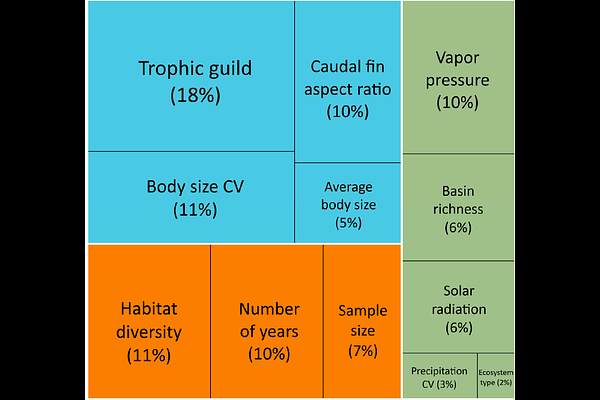What determines trophic niche breadth? A global analysis of freshwater fishes using isospaces

What determines trophic niche breadth? A global analysis of freshwater fishes using isospaces
Keppeler, F. W.; Giarrizzo, T.; Montana, C. G.; Adite, A.; Akin, S.; Angelini, R.; Arantes, C. C.; Benedito, E.; Bokhutlo, T.; El-Sabaawi, R.; Garcia, A.; Gonzalez-Bergonzoni, I.; Hoeinghaus, D.; Hoffman, J.; Jensen, O. P.; Jeppesen, E.; Kopf, R. K.; Layman, C. A.; Lopez, E. O.; Maitland, B. M.; Matsuzaki, S.-i. S.; Olin, J. A.; Paterson, G.; Quintana, Y.; Rezende, C. E. d.; Trudeau, A.; Trindade, P. A.; Turner, T. F.; Zandona, E.; Winemiller, K. O.
AbstractTrophic niche is one of the most tractable dimensions of a species niche. Several hypotheses have been proposed to explain global variation in species\' trophic niches, but empirical tests are limited. Stable isotope analysis (SIA) of d13C (a proxy for basal sources) and d15N (a proxy for vertical trophic position) has increasingly been used to estimate trophic niche variation. We performed SIA on a dataset of over 33,000 stable isotope samples from freshwater fishes across six ecoregions. For 541 populations (358 species), we estimated the size of the d13C x d15N isospace: a bivariate representation of trophic niche breadth. We evaluated isospace variation in relation to environmental factors, species traits, and sampling scale, testing both novel and long-standing hypotheses about the drivers of trophic niche variation. A Boosted Regression Tree Model best predicted isospace, with environmental and trait-based variables among the strongest predictors. Fish isospaces were broader in regions with warmer temperatures, higher humidity, and precipitation variability, suggesting that more productive, diverse, and seasonal ecosystems are associated with broader trophic niches. Conversely, isospace size declined with increasing basin fish richness, which may reflect heightened interspecific competition or historical competitive exclusion. Isospace size was slightly smaller in large lakes compared to rivers, streams, and small lakes. Within-population variation in body size was strongly and positively associated with isospace size, highlighting the role of ontogenetic dietary shifts. Fish with truncate-rounded fins had broader isospaces than those with forked-lunate fins, likely due to the former having more limited movement and greater spatial isolation that resulted in greater between-individual niche variation. Primary consumers had larger isospaces than intermediate and top consumers. Predators showed relationships consistent with those observed from analysis encompassing all trophic guilds, but non-predators deviated with regard to four variables: solar radiation, basin richness, average body size, and caudal fin aspect ratio. Isospace size increased with the number of sampled individuals, habitats, and years surveyed. Although isospace patterns have well-documented limitations as trophic ecology metrics, our findings nonetheless conform with several longstanding hypotheses for trophic niche variation and stimulate new ideas about environmental and biological drivers of niche breadth.